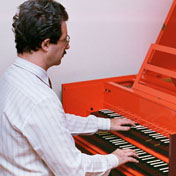Excerpts from the book
FOREWORDS TO THE EDITIONS OF 1985 AND 2003
Recent years have witnessed a most welcome tendency to return to the use of ancient techniques for Baroque keyboard playing. These techniques are essential to achieve a stylish performance of Baroque music. The well-known Dutch harpsichordist Ton Koopman wrote that he found “foolish to try and play old organ and harpsichord music using modern techniques. If one regards old fingerings as means of articulation, they appear extremely refined and effective.”
Unfortunately, there are still very few teachers and players using early techniques. One reason is that it is hard to find a reliable set of systematic rules. Old treatises like F. Couperin's and modern methods like Maria Boxall's provide many examples, but they alone are not sufficient, and sometimes they even include contradictory examples. The main difficulties for the modern performer arise in scale passages; however, these can be easily fingered and played with ancient techniques, provided we are able to keep in mind the manifold possibilities these techniques actually provide.
The method in this book consists of a comprehensive set of Baroque fingering rules ... . I am deeply indebted to Maria Boxall and to Mark Lindley: without their pioneering work in the field, this work would not have been possible.
... the first edition ... was immediately endorsed by Igor Kipnis ... Baroque fingerings ... for J.S. Bach ... [have been confirmed by] all the extant fingerings from Bach's circle. ... A reader reluctant to embark in ancient techniques, fearful that he/she will need to retain modern fingerings to play J.S. Bach, need not worry: although it requires years of practice, the Baroque technique—and its use for even the most advanced music of the time—is fully within the reach of the average modern harpsichordist and organist .... even the pinnacle of harpsichord technique—the Goldberg Variations and J.S. Bach's harpsichord concertos—are perfectly playable with strictly Baroque fingerings ....
CROSSING THE FINGERS
... One can broadly define two types of long-finger crossing movements ...:
- Crossing - Best in scales and also fast and/or legato or almost legato passages: ...
- Shifting - Less common, best for slow and/or non-legato to staccato passages: ...
The author finds that a flexible approach is best, using either way—and also intermediate ones—according to the particular passage and the articulation desired ... ultimately, each player has to find his/her “own convenience and gracefulness”, as very aptly put three centuries ago by Saint Lambert (Paris 1702).
2. DIATONIC SCALES - RIGHT HAND
...
Rule S - CROSSING OVER THE STRONG BEAT (MAINLY FOR INÉGALES)
Late Renaissance and early Baroque sources tended to stress the aim of fingering scales by placing the 3rd finger on metrically strong notes. ... [however] in mid and late Baroque times ... more often than not the opposite became the norm ... whenever possible the fingers should cross from a “strong” (long in inégales) to a “weak” note (short in inégales): this allows the player more time for crossing. The crossing movement is therefore more comfortable and, in the process, the player obtains a most natural rendering of the inégalité... The following example shows in red colour, over the original fingering by F. Couperin, an editiorial articulation written in modern notation.
Ex. RS-1. F. Couperin - L'Art de Toucher le Clavecin : “progrès d'octaves”

However, the reader should by no means feel that strong-to-weak crossings were an exclusive French practice. They are clearly prevalent in Alessandro Scarlatti ... showing that this tendency was present even in composers who wrote only in Italian style, with no inégales ...
Rule W - CROSSING OVER THE WEAK BEAT
Baroque musicians were not too rigid about rule S above. They followed it more often than not, but did not hesitate to disregard it whenever it was clearly not convenient, as in ... Les Ondes ....



